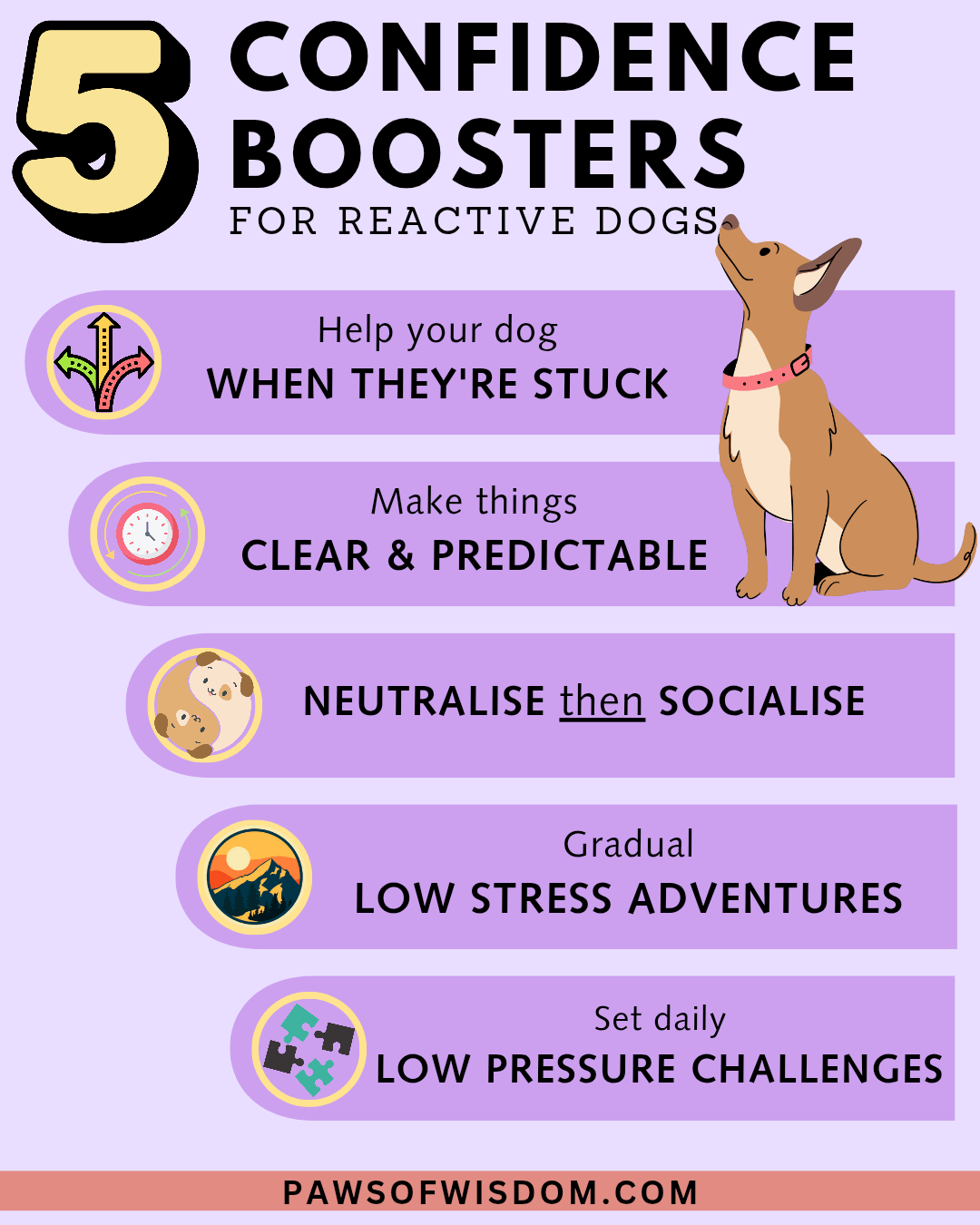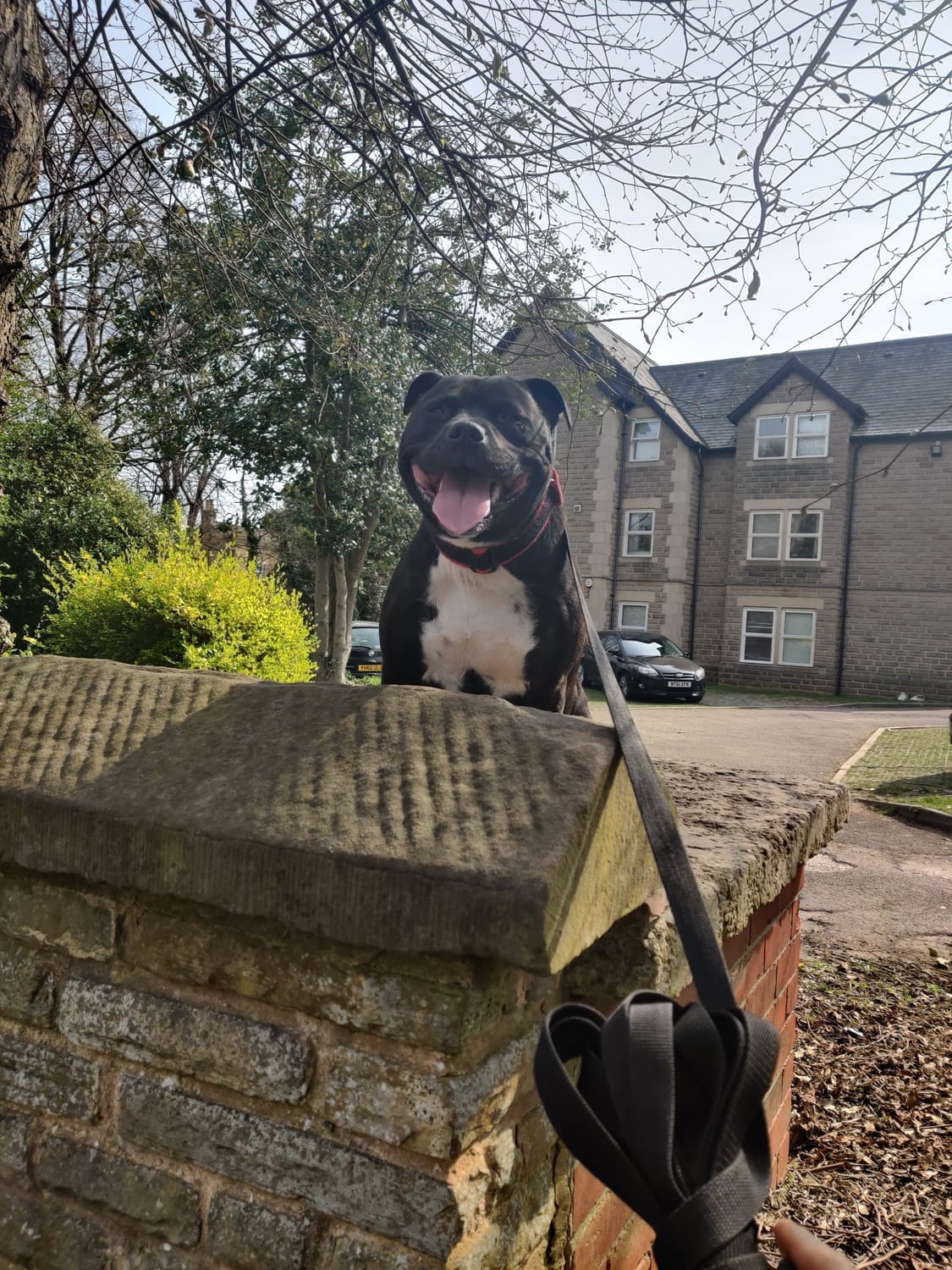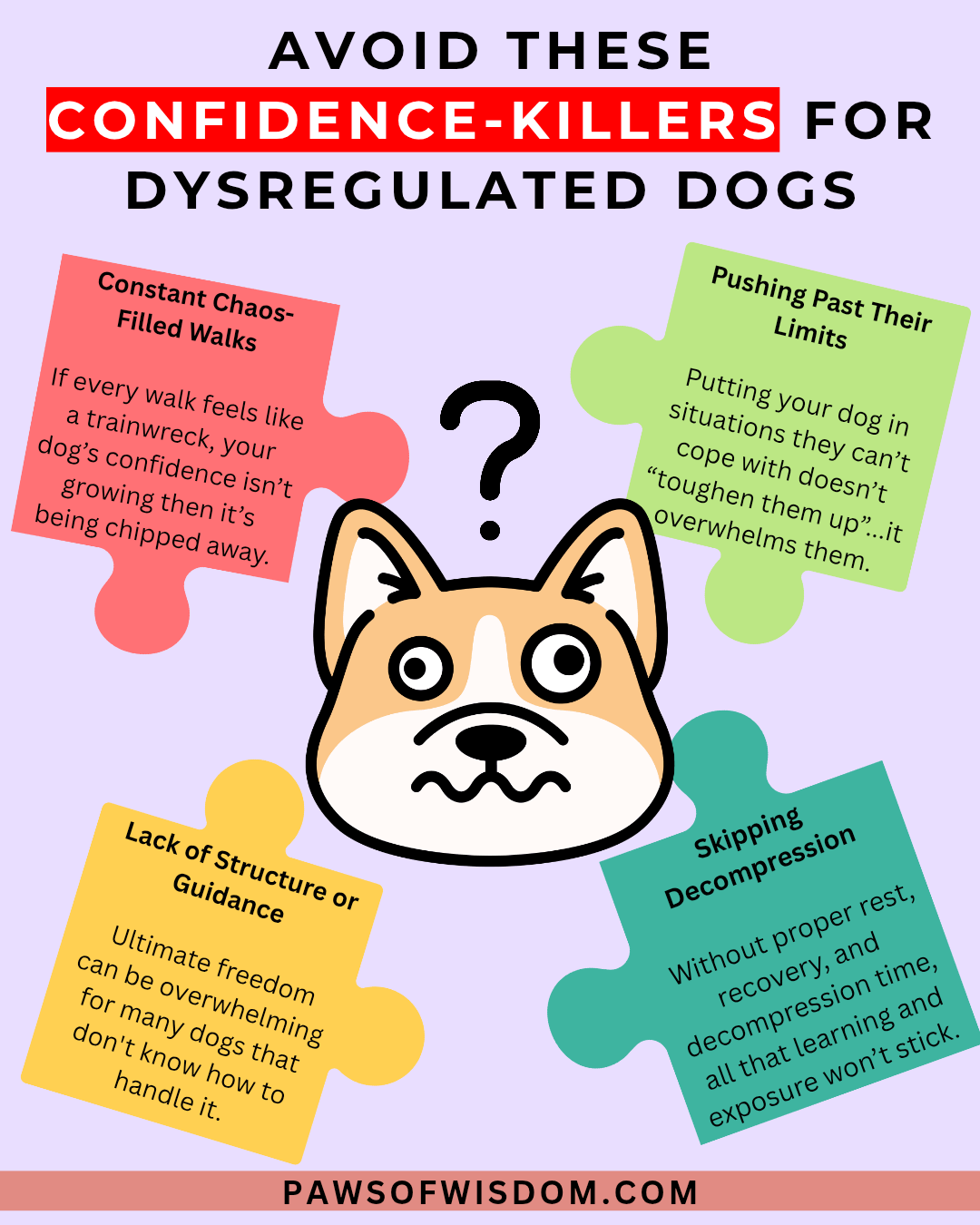5 Dog Confidence Building Exercises That Helped My Reactive Dog Thrive
If your dog seems scared of the world, lashes out when overwhelmed to create space, looks uncomfortable in new environments, or shrinks from anything unfamiliar…confidence might be one of the missing pieces.
Dog confidence building exercises aren’t just fun little challenges you do to pass the time, they’re often the bridge between reactivity and resilience, and often a lifeline for dogs who feel like the world is just too much.
Reactive dogs aren’t just “bad at walks” or “too much to handle.”
More often than not, they’re unsure, overstimulated, and desperately trying to stay afloat in a world that feels way too big.
That was my dog Jasper. It took me a while to realise he wasn’t stubborn; he was scared, frustrated, and dysregulated. And the more I tried to train the symptoms, the more stuck we both felt.
Confidence played a major part in helping him come out of his head and into the moment.
In this post, I’m sharing the five dog confidence building exercises that helped Jasper go from reactive and insecure to more regulated, curious, and grounded — so your dog can start walking through the world with their head held high (instead of exploding at every corner).

Why Confidence Is Important For Reactive Dogs
Confidence plays a huge role in your dog’s ability to navigate the world in what we'd call a "social manner". For reactive dogs, a lack of confidence and structure is often at the heart of their outbursts; barking, lunging, or freezing is usually rooted in uncertainty, confusion, and fear, not defiance.
When your dog feels unsure or unsafe, their natural response can be to react (especially if their body is already signalling their discomfort), not because they want to cause trouble, but because they don’t yet have the tools to properly cope.
The key is in teaching your dog that the world doesn't have to be that scary and that they can trust you to guide them through it. The more confident your dog becomes in daily situations, the more they can think before reacting. You want to break the cycle and build a stronger foundation.
How Stress Impacts Confidence in Reactive Dogs
Confidence can’t grow in chaos.
One of the most overlooked obstacles to building a dog’s confidence is stress. It is a very common mistake to put dogs in situations they can't handle (unintentionally of course) and doing so consistently can put them under a lot of stress.
For many dogs, this can be on daily walks where they react, lunge, jump up and live in a state of constant chaos. When put in these situations, dogs don't just get better, the stress builds up and starts to become overwhelming.
This is where trigger stacking comes into play. It’s the build-up of stress from multiple triggers throughout the day, even if those triggers seem minor on their own. Over time, this can lead to emotional overload, making it difficult for dogs to cope with even basic situations. A confident dog feels in control. A stressed dog feels like they’re constantly trying to survive.
That’s why I always recommend starting with a reset — removing unnecessary stress, triggers, focusing on rest, building confidence and creating a predictable routine and foundation to tackle the world with.
5 Dog Confidence Building Exercises That Transformed My Reactive Dog
Rome wasn't built in a day, and confidence isn’t something you can build in one either. It's something you build through consistency, positive experiences, structure, and trust.
These five confidence building exercises for dogs helped Jasper go from nervous and reactive to more resilient, curious, and grounded.
They’re simple, practical, and adaptable for most dogs, no matter where you’re starting from...
Let's break them down...
#1 - Free Shaping: Letting Your Dog Figure Things Out
I love free shaping — not just because it’s fun, but because it teaches dogs how to try. Not just how to do things right, but how to keep going even when they’re not sure what the “right” thing is yet.
There’s no pressure to get it perfect. No “wrong move” that ruins the moment. Just curiosity, choice, and progress one tiny step at a time.
Whether it’s stepping onto a box, sniffing a new object, or interacting with something unusual in their environment, shaping helps dogs learn that their actions can lead to rewards (or consequences).
Why it works: It builds decision-making skills, frustration tolerance, and self-confidence.
I used this with Jasper a lot to help with frustration, but the ripple effect on his confidence was undeniable. He learned that it’s okay to be unsure and that trying something often leads somewhere good.
#2 - Obedience Foundations: Building Engagement and Clarity
A lot of confidence can be built from freedom and exploration, the ability to be curious and investigate. It can also come from clarity in situations and being able to guide them when things get stressful.
Obedience is also a fun for confidence building, a lot of dogs can find a lot of fun and structure in obedience, plus it allows for engagement with you.
Why it works: Obedience isn’t just about control, it’s about communication and is great for building confidence.
With Jasper, having a set of clear, practised behaviours gave him something familiar to fall back on when things felt overwhelming; confidence came from knowing what was expected, what earned a reward, and that he was actually capable of new things.
#3 – Neutrality: Teaching Calm Observation Without Pressure
One of the most powerful ways to build confidence in a reactive dog is by teaching neutrality — the ability to see things that used to cause a meltdown and realise they don’t have to react.
Neutrality isn’t about exposure for exposure’s sake. It’s not about pushing them to “get over it.” It’s about helping your dog stay regulated in the presence of triggers, without forcing interaction or putting them over threshold.
The biggest mistake I see? Rushing this stage.
People put their dogs too close, too fast, thinking they’re “socialising” or helping them build confidence — when really, they’re just overwhelming them and reinforcing fear and building bad habits.
Why it works: Neutrality builds confidence by letting your dog succeed at a safe distance.
With Jasper, I stopped trying to flood him with full-on exposure. Instead, we sat on benches far from the action. We watched the world go by. He learned that seeing other dogs, bikes, or people didn’t always have to mean chaos.
#4 - New Environments: Confidence Through Exploration
Exploring new, less-stressful environments is a great way to help build a dogs confidence (and adds decompression to your dogs day).
A quiet field, a back trail, or even an empty car park are all great areas you can encourage your dog to engage and explore their environment with little pressure and exposure to triggers.
Why it works: Confidence thrives when dogs are allowed to investigate the world without fear of overwhelm, when they know what to predict.
I used to take Jasper on little “missions” to calm, unfamiliar places and let him sniff, explore, and lead the way. No pressure. No strict agenda. Just the opportunity to learn that new doesn't always mean scary. If he really struggled I could use something like scatter feeding to try keeping him at ease.
#5 - Daily Challenges: Building Confidence One Small Win at a Time
Confidence can be built up from the smallest things, but the thing to note is that it is built.
Giving your dog simple, structured challenges like working for their food, agility courses, free shaping exercises, problems to solve, advanced obedience, obstacle courses etc...can help your dog feel more capable and in control.
Why it works: These daily exercises give your dog purpose, structure, and a sense of accomplishment. I started making sure I gave Jasper one tiny challenge a day — whether it was finding a scent trail, learning a new trick, free shaping a new behaviour, navigating a simple puzzle. Each time he succeeded, I could see him walk away a little taller (sometimes literally!).

BONUS #6 - Boosting Confidence One Step (or Jump) at a Time
Confidence isn’t always built through fancy tricks or obedience reps though. Sometimes, it’s built by simply stepping onto something new.
Encouraging your dog to climb onto low ledges, walk across different textures, go under benches, or balance on logs and benches can boost body awareness, problem-solving, and confidence all at once.
Some dogs might hesitate and that’s okay. You can gently guide them with treats, toys, or your own encouragement.
Why it works: This kind of challenge gives your dog a sense of capability. They learn that “I can do this” feeling and that carries into other areas of life. For dogs who tend to shrink or panic when things feel unfamiliar, these small physical wins can snowball into bigger emotional resilience.
Jasper used to freeze at the idea of jumping up on anything. We started with curbs. Then benches. Then logs on a trail. Now? He hops up like he owns the place.

What Not to Do When Building Confidence
While it’s important to focus on what helps your dog grow, it’s just as crucial to avoid the things that can undo all your hard work.
As mentioned, confidence doesn’t come from chaos...it comes from clarity, consistency, and security.
Here are some things that held Jasper back (and that I’ve seen hold back plenty of other dogs too):
Constant Chaos-Filled Walks Overstimulating environments do more harm than good. If every walk feels like a trainwreck, your dog’s confidence isn’t growing—it’s being chipped away. Avoid busy routes, triggers (even walks if you to) until your dog is truly ready for them again.
Pushing Past Their Limits Putting your dog in situations they can’t cope with doesn’t “toughen them up”...it overwhelms them. When done consistently a dog may be put in a situation where they have to act for themselves.
Lack of Structure or Guidance Confidence doesn’t mean your dog gets the freedom to make every decision. Dogs feel safer with structure and guidance, when you set the pace, choose the route, and provide predictable boundaries. Without that, they’re left to navigate everything on their own which can be overwhelming.
Expecting Too Much Too Soon Progress takes time. When we expect instant results or rapid transformation, we pile on pressure — often leading to disappointment and setbacks. Meet your dog where they’re at. Move at their pace.
Skipping Decompression A confident dog is a regulated dog. Without proper rest, recovery, and decompression time, all that learning and exposure won’t stick. Decompression isn’t optional...it’s foundational.

Turn Confidence Into Progress You Can Actually See
Building confidence doesn’t just happen during the training session — it happens when you track what’s working, reflect on what’s not, and give yourself the space to zoom out.
Sometimes it’s not the exercises that need tweaking but our ability to notice the change.
Maybe your dog’s barking less on walks.
Maybe they recovered faster from a trigger today.
Maybe you handled a meltdown without spiralling.
But unless you write it down, track the patterns, and look for the small wins, you’ll miss it. That’s where reflection becomes your secret weapon.
My Digital Dog Training Journal & Progress Tracker is designed to help you:
Track unwanted behaviours, triggers, and wins
Reflect on daily walks and confidence building sessions
Prioritise your goals and spot patterns over time
Stay organised — without paper piles or chaotic notebooks
Everything lives in one clean, digital space. No overwhelm. No guesswork. Just clarity and momentum — right from your phone, tablet, or laptop.
👉🏾 Start tracking progress with your own Dog Training Journal today and give your confidence-building work the support system it deserves.
Final Thoughts
Dog confidence building exercises aren’t quick fixes. They’re the slow, steady undoing of fear, broken expectation and deep rooted chaos. The tiny, unglamorous moments where your dog hesitates…and then tries again.
It’s never flashy.
It’s not linear.
And sometimes it feels like absolutely nothing is working until one day, your dog pauses instead of panicking. Checks in instead of shutting down. Steps forward instead of freezing.
These are the moments everything starts to shift!
These exercises helped Jasper stop reacting to the world and start to actually explore the world instead...hopefully they can be of some use to you.
Frequently Asked Questions (FAQs): Building Confidence in Fearful or Reactive Dogs
Start small. Use confidence building exercises like free shaping, sniffari walks, desensitisation etc. Celebrate tiny wins, offer plenty of positive reinforcement, and avoid pushing them into situations they’re not ready for. Confidence grows through calm, consistent exposure—not chaos and pressure.
Low confidence can stem from a mix of things including genetics, poor socialisation, trauma, inconsistent environments, or being repeatedly put into situations they couldn’t cope with. Dogs that don’t feel secure or understood often develop fearful or reactive behaviours as a coping strategy.
Training an insecure dog is about setting them up for success. Use simple, achievable exercises to challenge them but not overwhelm them. Focus on predictable routines and structure, calm environments, and reinforcing positive behaviours.
Avoid flooding (throwing them into situations where they get overloaded like a busy dog park if your dog struggles with dogs), harsh corrections, or expecting them to “just get over it.” Don’t ignore signs of stress or force interactions.
Related Reading
A FREE community with downloadable guides and resources, and people who get it.
A simple and structured reset for overstimulated, dysregulated, chaotic dogs.
Simple, clear guidance to help you understand your dog through a regulation-first lens.











